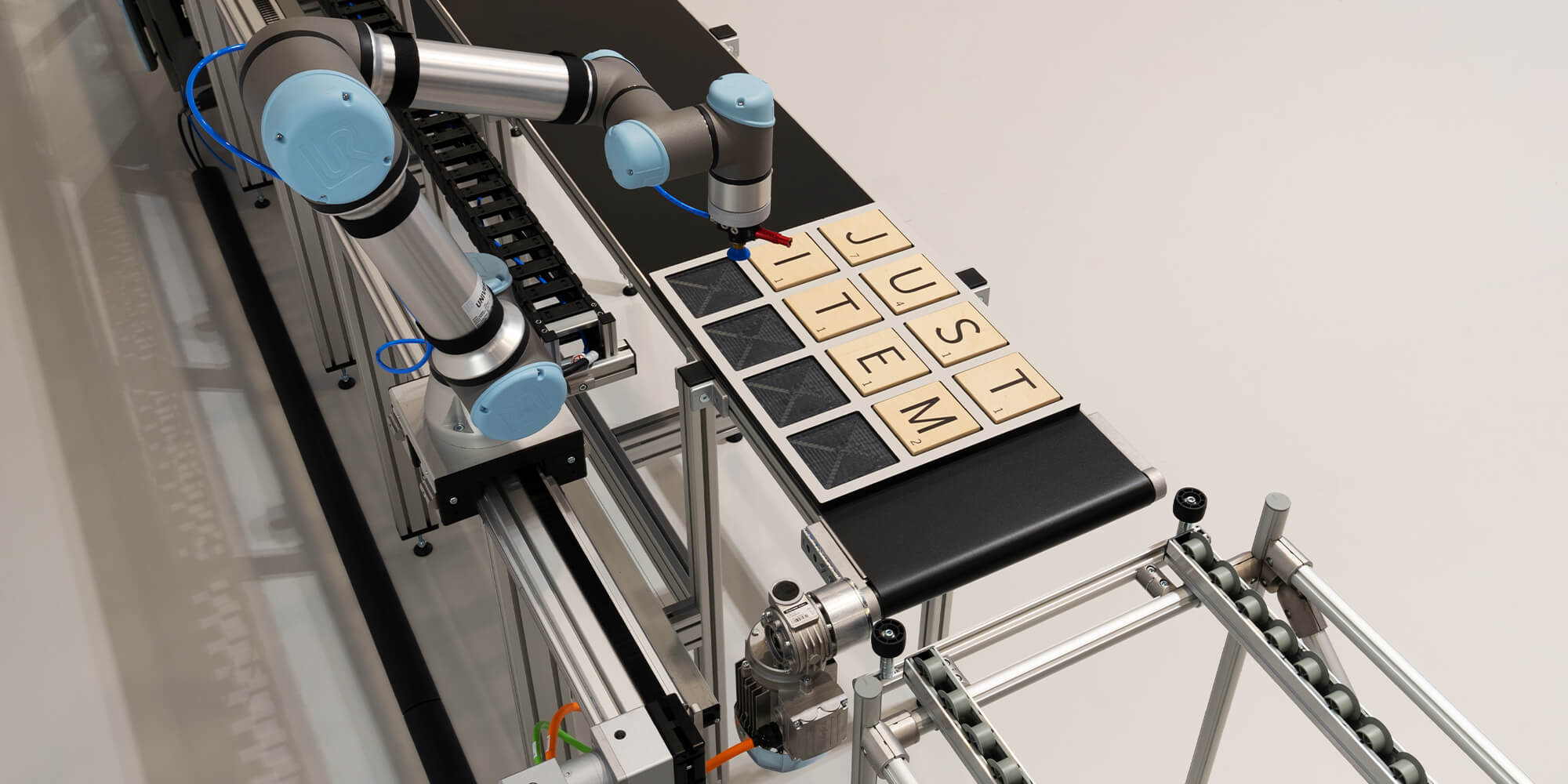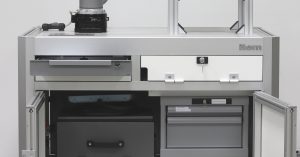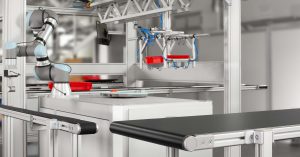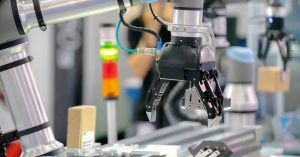A seventh axis extends a robot’s operating range – a conveyor belt, linear unit and cobot combine in a practical student project.
The core principle of the cooperative study programme concept is studying at a university while at the same time gaining valuable experience at a company. Jan Tollewski from Solingen had his heart set on a degree of this kind from an early stage, and he contacted item directly: “I already knew someone who worked for item and I spoke to him about the company. It all sounded very positive, so I knew I wanted the practical part of my degree to be at item.” During his interview, he chose to study at Bochum University of Applied Sciences. Jan is now in his eighth semester at the Campus Velbert/Heiligenhaus, where he is studying Mechatronics and Product Development (Bachelor of Engineering) under a Cooperative Engineering Training (KIA) programme. During term time, students spend two days at the cooperating company and three days at the university. They carry out three KIA projects to put the theory they have learned into practice. For his final KIA project before his bachelor thesis, the 27-year-old teamed up with a fellow student at item. Julius Kuczkowiak is studying electrical engineering at Bonn-Rhein-Sieg University of Applied Sciences. Following a practical semester, he has returned to item as a student trainee. Together, the two students created the inspirational Range Extender test set-up. At its heart is a robot arm with a seventh axis that rearranges workpieces while they are being transported.
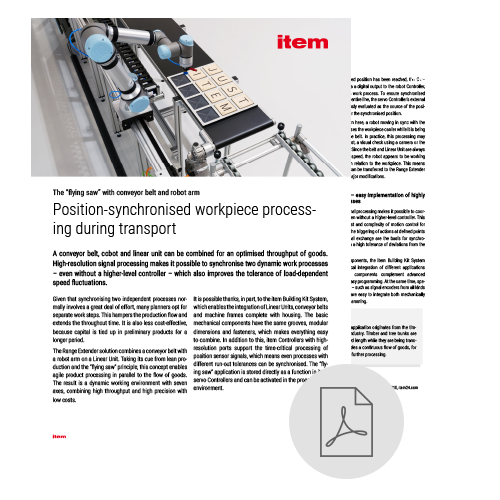
Would you like to create a similar robot application?
From servo controller and incremental encoder to process coordination – the directly accessible Range Extender PDF covers all the technical details. Grab some inspiration!
ACCESS NOW
Linking product areas and synchronising work processes
The third KIA project always involves linking different product areas. The Range Extender project is a perfect example. The name says it all, because the robot’s special design means it has a seventh axis and thus an extended operating range. A linear axis from the item Linear System runs parallel to a six-metre-long Flat Belt Conveyor from the item Conveyor Belt System. The cobot is located on the linear axis. It is connected to a frame with a roller conveyor based on the Lean Production Building Kit System. All basic mechanical components are designed with the same grooves, modular dimensions and fasteners, so everything can be flexibly combined. “We set ourselves the challenge of minimising the number of components used. The Conveyor Belt System’s profile groove made it easy for us to assemble and link everything. item is unbeatable when it comes to modularity,” says Jan. The cobot’s actual task is to rearrange puzzle pieces on a workpiece carrier in sync with the moving conveyor belt. The carrier then continues its journey on the roller conveyor.
Other cobot models can also be used – all that is needed is a different pattern of holes on the Linear Unit’s 200 x 200 cm carriage plate.
A further advantage of this set-up is that no higher-level controller is required. item servo Controller BL 1-04 C communicates directly with the relevant cobot. The Universal Robots UR5, the ABB CRB 15000 and the Doosan A0509 have been successfully implemented to date. Other cobot models can also be used – all that is needed is a different pattern of holes on the Linear Unit’s 200 x 200 cm carriage plate. Only two non-item components were used – an incremental encoder and a photoelectric sensor. The encoder measures the speed of the conveyor belt. The data is evaluated by the servo Controller with high-resolution signal processing, as Jan explains: “Let’s assume a heavy weight is suddenly placed on the conveyor belt and slows it down. The linear axis on which the robot is moving then also automatically slows in parallel and the cobot continues at this modified speed.” The process is triggered as soon as the workpiece carrier passes through the photoelectric sensor. This starts the linear axis and cobot, with the trigger signal simultaneously providing an absolute synchronised position.
From flying saw to robot with a seventh axis
An application called the “flying saw” provided the inspiration for the Range Extender project. It was originally used in timber processing, cutting timber and tree trunks to size while they are being transported. In this case, too, goods transport and simultaneous further processing thus go hand in hand. Having a robot with a seventh axis arrange puzzle pieces may just seem like a game, but the wide range of potential uses should not be underestimated. “Basically speaking, there are no limits. The solution can be used for the same kind of sorting task as here on our set-up, but with an additional system to perform a visual check. Bonding and joining processes, packaging components and applying a seal are further possible options. I can also definitely see it combining individual parts, with several conveyor belts converging,” says Jan. The end-to-end compatibility of item products means no holds are barred when it comes to getting creative. Newer areas such as the building kit system for cobot solutions or the Conveyor Belt System can be seamlessly combined with all other components. Ever since the early days, item has set great store by a classic and uniform design for all products. That also means everything has a look that matches perfectly.
I’m very content and get a real taste of working life here at item. The combination of theory and practice works really well, too.
Jan has now almost completed his degree. He already has a “successor” at item, who came on board in the 2021 winter semester. Although this recent arrival is on a different cooperative study programme at the Bochum University of Applied Sciences, many of the courses are the same. Jan is therefore happy to help his fellow student with recommendations relating to both studying and practical work. Essentially, he spends his working days at item carrying out other minor project tasks and supporting the colleagues he appreciates so much. During the university holidays, when he is on site five days a week, there is naturally more scope in this respect. Jan has only positive things to say about his work and his studies: “I’m very content and get a real taste of working life here at item. The combination of theory and practice works really well, too. There have been many occasions when I’ve realised during a lecture that I’ve already seen the process in question at item or have been able to contribute something at uni because of having already done it here at the company.”
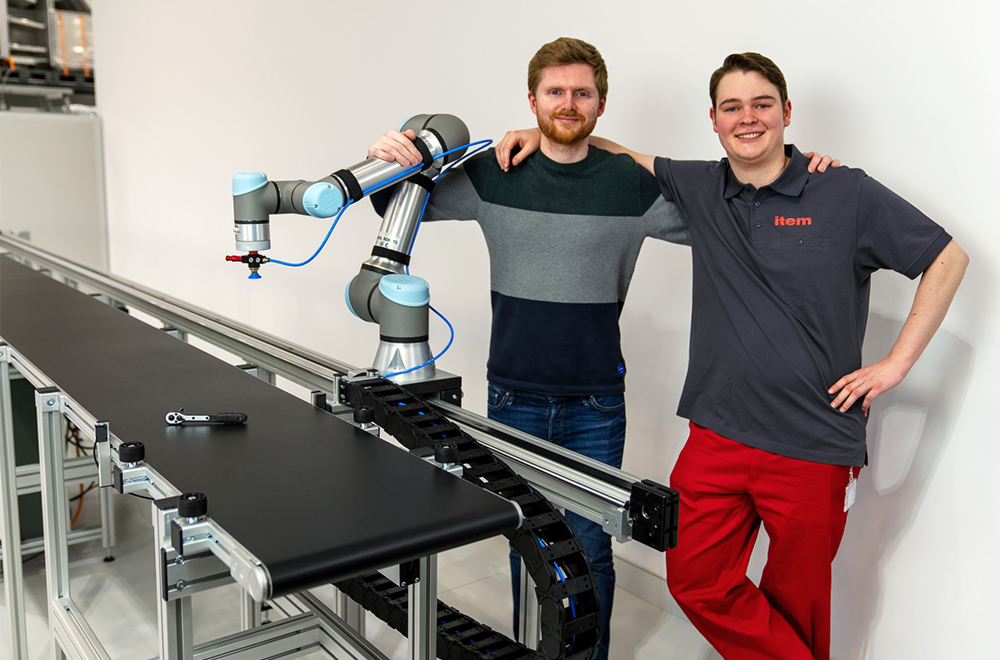
Do you want to be bang up to date on the latest news from the world of robotics? Simply subscribe to the item blog by completing the box at the top right.

